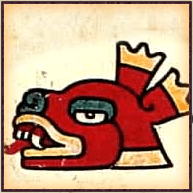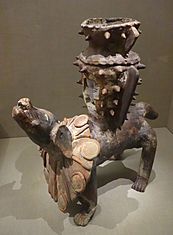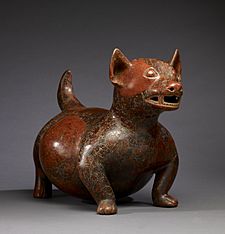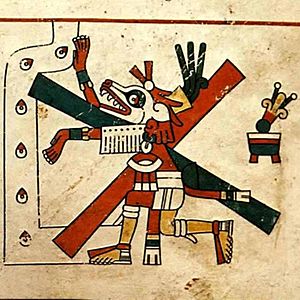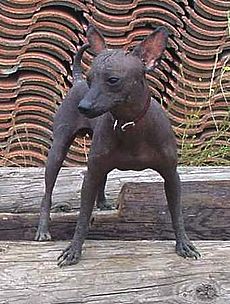Dogs in Mesoamerican folklore and myth facts for kids
Dogs have always been very important in the stories and beliefs of ancient Mesoamerican cultures, like the Maya and Aztecs. This has been true for thousands of years, right up to today. A common belief was that a dog would help people who had just died cross a body of water to reach the afterlife.
Ancient Maya pottery shows dogs in scenes from the underworld. Even earlier, people in a place called Chupícuaro buried dogs with the dead. In the big city of Teotihuacán, archaeologists found 14 human bodies, mostly children, buried with three dogs. These dogs were meant to guide them on their journey to the underworld.
The Xoloitzcuintli is a special hairless dog from Mesoamerica. Evidence of this breed has been found in tombs of the Colima, Maya, Toltec, Zapotec, and Aztec people. This shows the breed is over 3,500 years old!
People believed Xolos were guardians and protectors. They thought these dogs would keep evil spirits and intruders away from their homes. In ancient times, Xolos were sometimes sacrificed and buried with their owners. This was so they could guide the owner's soul to the underworld. These dogs were also seen as a special food. They were eaten during important ceremonies, like weddings and funerals.
In many versions of the 20-day Mesoamerican calendar, the tenth day is named after the dog. In Nahuatl, the Aztec language, it's itzcuintli. In the K'iche' Maya language, it's tz'i'. In Yucatec Maya, it's oc. Among the Mixtecs, the tenth day was for the coyote, called ua.
Dogs in Maya Culture
When archaeologists find ancient Maya burials from the Classic Period, they often find animal remains, especially dogs. For example, in the ruins of the Maya city of Kaminaljuyu in Guatemala, a dog was found buried with a human skeleton. This shows that the belief about dogs guiding souls to the underworld was already strong back then.
Sometimes, in old Maya books called Maya codices, dogs are shown carrying a torch. This might be a story about how dogs brought fire to humans.
In the Postclassic Popol Vuh, a sacred book of the K'iche' Maya, dogs and turkeys got revenge on people. They killed the people of the second age because humans had beaten them. The few people who escaped this fate turned into monkeys.
Another story in the Popol Vuh tells about the Maya Hero Twins. They sacrificed a dog that belonged to the Lords of the Underworld, also known as Xibalba. After the dog died, the Hero Twins brought it back to life. The Lords were so amazed that they asked the twins to sacrifice and bring them back to life too. But the Hero Twins sacrificed the Lords of Xibalba and did not bring them back. This made it possible for humans to live on Earth. This story connected dogs with new beginnings and human life. Dogs were also linked to death and had the job of leading people into the Underworld. They also represented fire and were seen as protectors of the home.
Dogs in Aztec Culture
In Aztec mythology, there was a story about the Fourth Sun ending in a big flood. A man and a woman survived by hiding inside a log. They landed on a beach and quickly built a fire to cook some fish. The smoke from their fire bothered the stars Citlallatonac and Citlalicue. This made the great god Tezcatlipoca very angry. In his anger, he killed the man and woman, and from their bodies, he created the first dogs.
Among the Aztecs, the god Xolotl was a dog-like monster. During the creation of the Fifth Sun, Xolotl was chased by Death. He tried to escape by changing into a corn sprout, then into maguey leaves, and finally into a salamander in a pool of water. The third time Death found Xolotl, he caught and killed him. From Xolotl's body, important foods were created.
Mictlantecuhtli, the Lord of the Dead, had the bones of humans from earlier creations in the underworld. Xolotl went down to the underworld to steal these bones. He wanted humans to be reborn in the new creation of the Fifth Sun. Xolotl succeeded in getting the bones and helped bring humans back to life.
Xolotl was also seen as the planet Venus when it appeared as the Evening Star. His twin brother, Quetzalcoatl, was the Morning Star. Xolotl was like the Sun's dog companion, following its path through the sky and the underworld. Xolotl was strongly connected to the underworld, death, and the dead. This was shown by the symbols he carried. In the Codex Borbonicus, Xolotl is pictured with a knife in his mouth, a symbol of death. He also has black wavy hair, like the gods of death.
The fourteenth 13-day period of the tonalpohualli calendar began with the day ce itzcuintli (1-dog). People, especially rulers, were thought to be very lucky if they were born on this day. The tenth day of the xiuhpohualli 20-day farming calendar, itzcuintli (dog), was ruled by Mictlantecuhtli, the powerful lord of the dead.
In the Postclassic period, when an Aztec commoner died, they had to pass through nine levels of Mictlan, the underworld. It was believed that it took four years of wandering to reach Mictlan. The deceased was accompanied by a dog that had been cremated with them. The first level of Mictlan was called Apanoayan, which means where one crosses the river. This place was also known as Itzcuintlan, or the Place of Dogs, because many dogs roamed near the shore. A dog that recognized its former owner would carry them across the river on its back. Some stories say that dogs of different colors acted differently. Yellow dogs would carry the soul, while white dogs refused because they had just washed. Black dogs refused because they had either just swum the river or were dirty.
In Aztec stories, the ahuizotl was a dog-like water monster. It had a hand at the end of its long, coiled tail. It was said to live underwater near river banks. It would drag people who weren't careful into the water to drown them. The victim's soul would then be taken to Tlalocan, one of the three Aztec paradises. A similar belief existed among the neighboring Purépecha people. Their dog-god was called Uitzimengari. He saved the souls of drowned people by carrying them across to the Land of the Dead.
Modern Dog Folklore
Even today, some groups like the Chinantecs and Mixes of Oaxaca believe that a black dog helps the newly dead cross water to the land of the dead. The Huitzilan people believe a dog carries the dead across water to reach the underworld home of the Devil.
Across much of Mexico, people believe that evil sorcerers can turn themselves into a black dog. They do this to steal livestock from their neighbors. In central Mexican states like Oaxaca, Tlaxcala, and Veracruz, such a sorcerer is called a nahual. In the Yucatan Peninsula, they are known as huay chivo. Another supernatural dog in Yucatan folklore is the huay pek (which means "witch-dog" in Yucatec Maya). This is a huge phantom black dog that attacks anyone it meets. It is said to be an incarnation of the Kakasbal, an evil spirit.
A folktale from Tlaxcala tells how some hunters saw a huge black dog one night. They decided to try and catch it. The dog ran away when they came closer. One hunter shot at it, wounding its leg. Following the blood trail, they found a richly furnished hut. The owner of the hut was tending a wound on his own leg. The hunters realized what was happening and went to the nearest village. The local people told them that the peasant was a nahual who could turn into a dog to steal things.
The Tzeltal and Tzotzil Maya of highland Chiapas in Mexico have a story about creation. They say that a white dog mated with Eve in the Third Creation, and this created the Ladino people. A yellow dog, they say, was the father of the indigenous peoples.
A Jakaltek tale from the Guatemalan Highlands tells how the first dog saw the creation of the world. It ran everywhere, telling everyone the secrets of creation. Hunab' Kuh, the Creator-God, was very angry. He swapped the dog's head for its tail and its tail for its head. Now, whenever a dog wants to talk and give away its secrets, it cannot speak. Instead, it can only wag its tail.
Images for kids
See also
 In Spanish: Perros en el folclore y la mitología mesoamericanos para niños
In Spanish: Perros en el folclore y la mitología mesoamericanos para niños


